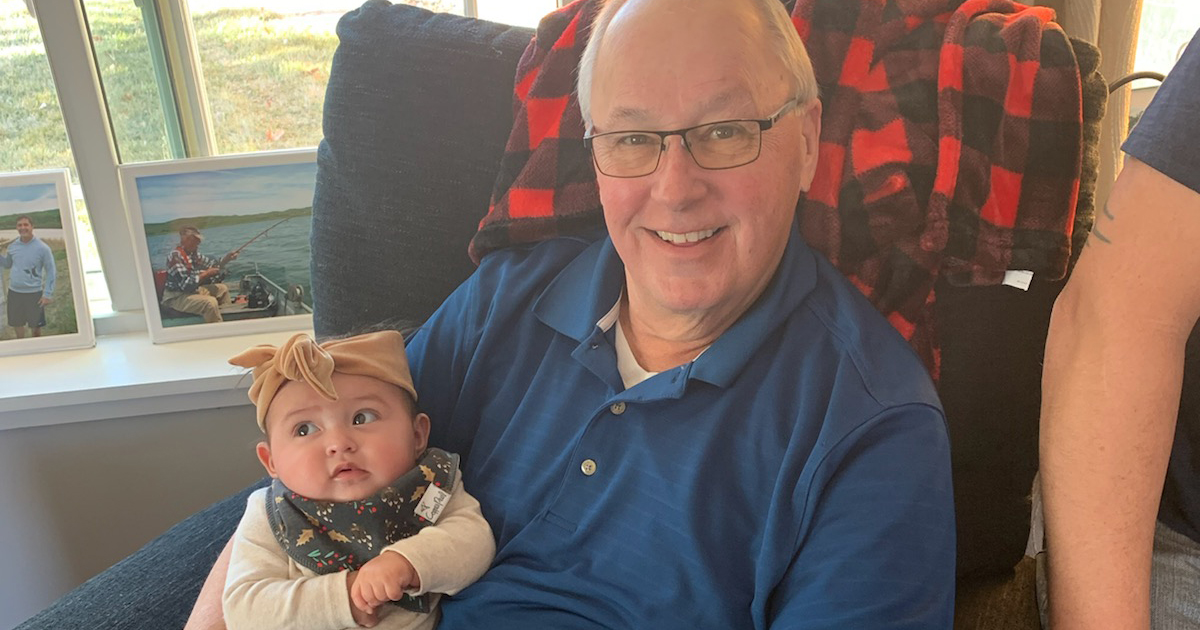A new way to treat resistant cancers

"The walls of the University of Nebraska Medical Center buildings are lined with the many names of dedicated and talented men and women who have spent a lifetime caring for and contributing to the success of this institution."
These are the words of Bradd Richter in a beautifully written, thoughtful and detailed thank-you note. He wrote it to all the people who cared for him: doctors, nurses, research scientists and the rest of his team.
Richter lives in Doniphan, Nebraska, which is about a two hour drive to the Nebraska Medical Center. When he needed cancer treatment, Richter said with no hesitation, "Yeah, I'm coming here."
Confidants with disease expertise
In 2013, Richter was diagnosed with stage 4 follicular lymphoma. The cancer was located in the right side of his lymph system as well as an area on his spine. After radiation and chemotherapy, he went into complete remission.
Unfortunately, the cancer came back. In 2019, his relapse spread from his neck to his collarbone.
A biopsy of the recurrent area revealed that the tumor was still a follicular lymphoma, but that it had taken on a new gene mutation: a "double-hit lymphoma." Double-hit lymphoma cancer is rare. So rare, in fact, that standard evidence-based guidance to make treatment decisions doesn't exist. Double-hit lymphoma affects more genes than in other types of lymphomas. So containing or curing double-hit lymphoma is often more difficult.
In situations like this, Richter's primary oncologist, Robert Gregory Bociek, MD, advocates teamwork.
"For our most challenging cases, we have a multidisciplinary conference every week. As a team, we review the data, talk about new treatments and see how patients are responding. It's where the magic happens," says Dr. Bociek.
Because of how rare and resistant to drugs double-hit lymphoma is, there's no standard playbook. Doctors must make decisions without the benefit of approved treatments (or published data). In situations with no easy answers, Dr. Bociek asks his patients what their goals are.
"Our job is to be the best combination of disease expert and confidant, to really understand what a patient wants to accomplish with their care," says Dr. Bociek.
For Richter, spending time with his grandchildren meant everything. So that's what Dr. Bociek and radiation oncologist Charles A. Enke, MD, worked toward, as a team. Dr. Bociek says, "We help each other make the right choice."
A novel idea: Twice-daily radiation
Double-hit lymphomas spread quickly and resist drugs, which is why it usually means a poor prognosis. Richter's lymphoma did show resistance to chemotherapy. These lymphomas are also frequently resistant to standard once-daily radiation therapy.
So Dr. Enke had a novel idea – why not try radiation therapy twice a day instead of once a day? The increased frequency of radiation might be enough to overcome the resistance observed with his chemotherapy.
Twice-daily radiation means a patient's treatment goes from four weeks to only two. Dr. Enke started performing twice-daily radiation many years ago after observing these aggressive lymphomas grow during once-a-day radiation therapy. With Richter's cancer not responding to standard chemotherapy treatment, he explained the process to Richter. Richter said yes.
He trusted Dr. Bociek and Dr. Enke completely. Twice-daily treatment was not easy, but Richter trusted his care team to "do the right thing." He described the Nebraska Medicine pledge of extraordinary care as, "Human beings taking care of other human beings."
Giving Richter his cells - and his life - back
After the twice daily radiation, Richter received additional chemotherapy followed by an autologous stem cell transplant. The stem cells were from Richter himself: the "auto" means "self." Doctors took Richter's healthy stem cells, kept them safe and then returned the stem cells to his body after treatment.
One hundred days after Richter's stem cell transplant, it was time for a PET scan to see what the cancer was doing. The result? Remission.
The twice-daily treatment had worked – even with Richter's resistant lymphoma.
Dr. Enke is quick to share the credit for Richter's incredible progress. "A successful cancer treatment requires a true team effort – the doctors, therapists, nurses, staff, and radiation team must all work together. I couldn't be successful without my team," says Dr. Enke.
The whole team loved Richter's beautiful thank-you note. He is thankful to everyone involved, saying, "Scientists and doctors work hard to help people like me have long lives. They don't get enough recognition."
He's also a man of deep faith, saying, "No matter what happens, God's in control. I'm thankful for his healing work in my life." Richter is grateful to spend additional time with his family, including his ninth grandchild, sweet little Ima June.




